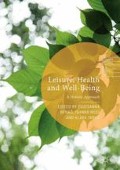Abstract
We present observations on wellness customers whom we interviewed in wellness hotels (N=41) and a hot springs resort (N=107) in 2009 and 2010. Among the customers interviewed, only a small number are dedicated to a “healthy lifestyle” based on continuous physical activities (for example, fitness) and the regular consumption of wellness services. For the majority, wellness is something special, a kind of self-indulgent gratification, allowing them to rest and compensating for work stress. The use of wellness services is seen as a positive programme in contrast to the consultation of medical doctors, whose behaviour is perceived as instrumental and standardized. Wellness satisfies three needs: (1) instant relaxation and the improvement of well-being; (2) the (therapeutic) interaction which accepts the client and his/her individuality thoroughly; (3) the mixture of innocuous intimacy of bodily contact, emotional care and spiritual animation.
This chapter is part of the results of a study on the professionalization of wellness services in Germany (Grant 01FB08023 of the German Ministry of Research and Education), in which service providers and customers were studied. Theoretically it refers to service research, professionalization theory and symbolic interactionism.
Access this chapter
Tax calculation will be finalised at checkout
Purchases are for personal use only
Notes
- 1.
Dunkel and Weihrich (2010: 192) define three basic coordination problems of interaction work: (a) the coordination of the actions of the persons involved; (b) the problem of the definition of the object of service and its procedures; and (c) the problem of inconclusiveness of contracts, that is, that contracts always leave an open margin for interpretation, which means that service always bears the character of a promise for service.
- 2.
References
Antonovsky, A. (1979). Health, stress and coping. New perspectives on mental and physical well-being. San Francisco: Jossey-Bass Publisher.
Bengel, J., Strittmatter, R., & Willmann, H. (2001). Was erhält Menschen gesund? Antanovskys Modell der Salutogenese—Diskussionsstand und Stellenwert. Forschung und Praxis der Gesundheitsförderung Band 6. Köln: Bundeszentrale für gesundheitliche Aufklärung.
Bodens, C. (2003). Kritische Analyse der gesellschaftlichen Hintergründe des Wellnesstrends und die Reaktion des deutschen Touristikmarktes, Forschungskreis Tourismus und Management. Tier: Eigenverlag.
Böhm, K. (2007). Servicequalität und Gesundheitstourismus. Erfolgsfaktor für die deutschen Heilbäder und Kurorte. Berlin: VDM Verlag Dr. Müller.
Borowiec, T., & Janssen, B. (2010). Empirische Qualifikationsbedarfsanalyse im Wellnessbereich. Bonn: Bundesinstitut für Berufsbildung.
Dunkel, W., & Weihrich, M. (2010). Arbeit als Interaktion. In F. Böhle, G. Voß, & G. Wachtler (Eds.), Handbuch Arbeitssoziologie (pp. 177–200). Wiesbaden: VS Verlag.
Ennsfellner, I. (2011). Kontinuierliche Verbesserung—Der Konkurrenz immer voraus. In A. Krczal, E. Krczal, & K. Weiermair (Eds.), Qualitätsmanagement in Wellnesseinrichtungen Erfolg durch Kundenorientierung und hohe Standards (pp. 31–51). Berlin: Erichs Schmidt Verlag.
Hank-Haase, G., & Illing, K. (2005). Wirtschaftlichkeit und Rentabilität von Wellnessbereichen im Hotel. Wiesbaden: ghh Consult GmbH.
Harmsen, T. (2004). Die Konstruktion professioneller Identität in der Sozialen Arbeit. Heidelberg: Carl-Auer Verlag.
Hochschild, A. R. (2006). Das gekaufte Herz. Die Kommerzialisierung der Gefühle (Neuauflage 2006). Frankfurt, New York: Campus.
Horx, M., Horx-Strahern, O., & Gaspar, C. (2003). Was ist wellness? Anatomie und Zukunftsperspektiven des Wohlfühltrends. In Das Zukunftsinstitut (Eds.), Trend Dossier. Kelkheim: Eine Publikation von Mathias Horx in Zusammenarbeit mit der GfK Marktforschung.
Kalkowski, P., & Paul, G. (2011a). Professionalisierungstendenzen in Berufen der Wellness-Branche. Forschungsbericht des Soziologischen Forschungsinstituts Göttingen an der Georg-August-Universität, Göttingen.
Kalkowski, P., & Paul, G. (2011b). Professionalization in new and old health-related job in the wellness-sector in Germany. Sociology Study, 1(4), 294–301.
Kerschenbaumer, M. (2009). Qualität als Erfolgsfaktor in der Wellnesshotellerie. Integration eines wellnessbezogenen Kriterienmodells in ein Total Quality Management, Diplomarbeit Studiengang. Innsbruck: Management und Recht der FH Innsbruck, Management Center Innsbruck.
Kyrer, A., & Populorum, M. A. (2006). Trends- und Beschäftigungsfelder im Gesundheits- und Wellness-Tourismus. Berufsentwicklung, Kompetenzprofile und Qualifikationsbedarf in wellnessbezogenen Freizeit- und Gesundheitsberufen. Wien, Berlin: LIT Verlag.
Lanz-Kaufmann, E. (2002). Wellness-Tourismus—Entscheidungsgrundlagen für Investitionen und Qualitätsverbesserung. Bern: Forschungsinstitut für Freizeit und Tourismus der Universität Bern.
Lee, J. (2005). Investigating the hybridity of ‘wellness’ practices. Paper of the Department of Sociology, University of California, Theory and Research in Comparative Social Analysis, paper 28. Available at: http://repositories.cdlib.org/uclasoc/trcsa/28. Accessed 3 June 2011.
Sonnenschein, M. (2009). Medical wellness & co—Der Gesundheitsvorsorgetourismus in Deutschland Angebot und Nachfrage im Wandel. Berlin: Pro Business GmbH.
Tennant, R., Hiller, L., Fishwick, R. et al. (2007). The Warwick-Edinburgh mental well-being Scale (WEMBS); development and UK validation. In Health and quality of life outcomes. Available at: www.hqlo/com/content/5/1/63. Accessed 8 Mar 2010.
Verband, D. W. (2007). Wellness-Marktdaten. Nicht Dumpingpreise im Fitnessmarkt—Kundenbetreuung eröffnet enormes Wachstumspotenzial. Available at: http://www.wellnessverband.de/infodienste/marktdaten/070903_deloitte.php. Accessed 8 Nov 2011.
Weber, D. (2006). Wachstumspotenziale im deutschen Markt für Gesundheitsdienstleistungen. Saarbrücken: VDM Verlag Müller.
Author information
Authors and Affiliations
Editor information
Editors and Affiliations
Rights and permissions
Copyright information
© 2017 The Author(s)
About this chapter
Cite this chapter
Kalkowski, P., Paul, G. (2017). Wellness Customers and Their Needs. In: Benkő, Z., Modi, I., Tarkó, K. (eds) Leisure, Health and Well-Being. Leisure Studies in a Global Era. Palgrave Macmillan, Cham. https://doi.org/10.1007/978-3-319-33257-4_6
Download citation
DOI: https://doi.org/10.1007/978-3-319-33257-4_6
Published:
Publisher Name: Palgrave Macmillan, Cham
Print ISBN: 978-3-319-33256-7
Online ISBN: 978-3-319-33257-4
eBook Packages: Social SciencesSocial Sciences (R0)

